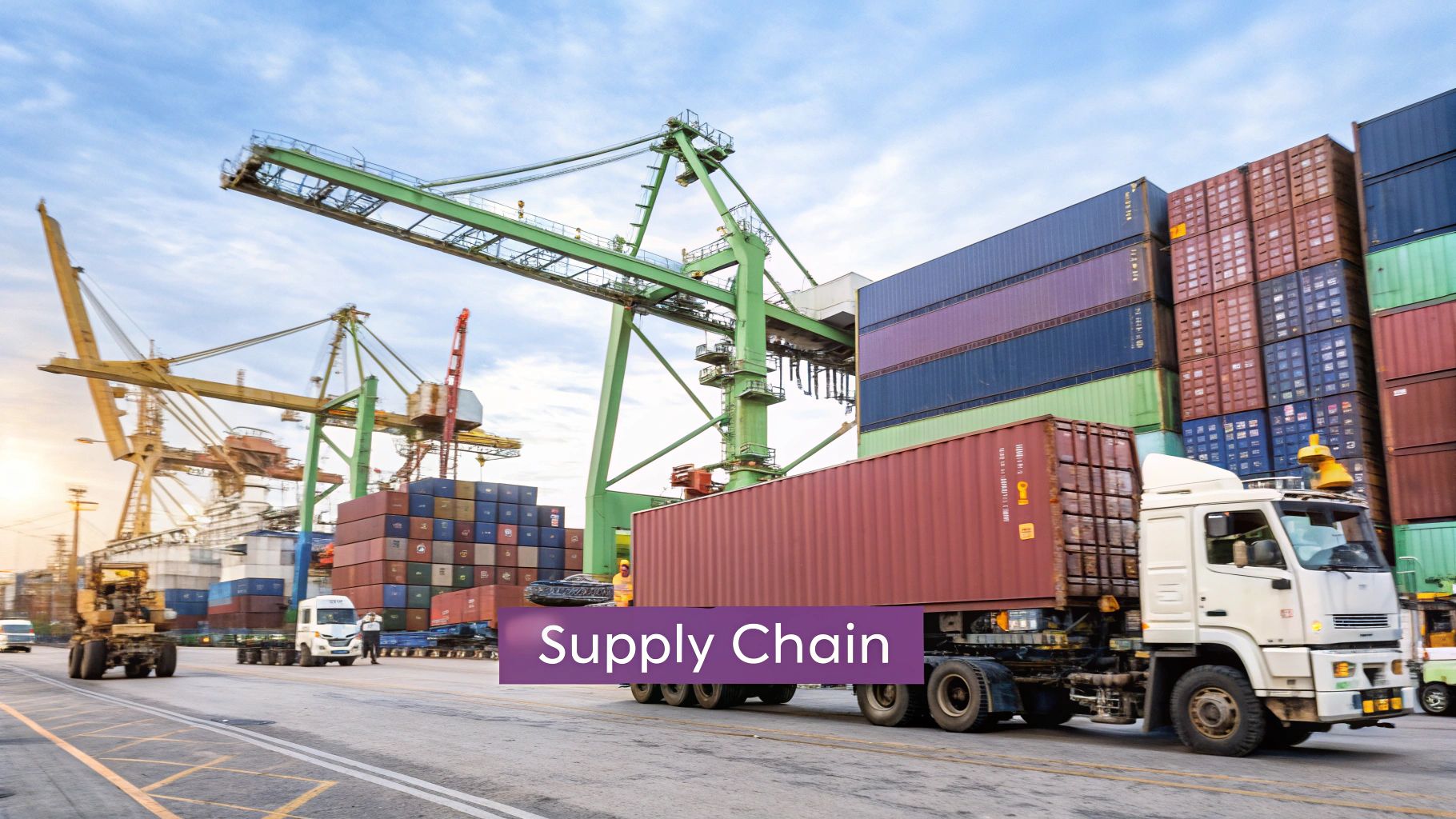In a competitive market, managing expenses isn't just about survival; it's a strategic advantage. While many businesses look to broad operational cuts, one of the most significant and often overlooked opportunities for savings lies within customer support. This department, traditionally viewed as a cost center, can be transformed into a model of efficiency and value. The key is implementing smart cost reduction strategies that enhance, rather than compromise, the customer experience.
This article moves beyond generic advice and provides a detailed roadmap to slash operational expenses across your business, with a special focus on support functions. We will explore nine powerful strategies, from supply chain optimization to workforce management, and demonstrate how AI-powered tools like FlowGent AI can execute them. To truly unlock the goldmine of savings within your support budget, begin by understanding the advantages of process automation, which explicitly targets efficiency and cost reduction.
You will learn actionable methods to automate repetitive tasks, reduce administrative overhead, and leverage technology for scalable growth. Each point provides practical implementation steps, ensuring you can apply these insights directly to your operations and start seeing immediate financial benefits.
1. Strategy 1: Automate Tier-1 Support with AI Agents
Tier-1 support is your frontline, handling common, high-volume, and often repetitive customer inquiries. These include questions like "Where is my order?" or "How do I reset my password?" While essential, staffing this tier with human agents 24/7 is a significant operational expense and a classic target for effective cost reduction strategies.
How AI Delivers This Strategy
By deploying AI agents like FlowGent AI, you can automate the entire Tier-1 workflow. These agents integrate directly with your existing systems, such as your CRM, e-commerce platform, and knowledge base. When a customer asks a common question via chat, email, or a support portal, the AI instantly accesses the relevant data to provide a precise, immediate answer. This frees human agents to focus on complex, high-value Tier-2 and Tier-3 issues that require critical thinking and empathy. A foundational step in reducing support costs is to strategically automate customer service, enhancing efficiency and customer satisfaction.
Implementation in Action
- E-commerce: An online retailer can use an AI agent to handle all order status inquiries, return requests, and product information questions. The agent checks the order management system and provides real-time tracking links or initiates the return process automatically.
- SaaS: A software company can deploy an AI agent to guide users through account lockouts, password resets, and basic feature navigation, pulling answers directly from help documentation.
Key Insight: Automating Tier-1 support doesn't just cut costs; it improves the customer experience by providing instant, 24/7 resolutions for the most common problems, eliminating wait times entirely.
2. Supply Chain Optimization
A well-oiled supply chain is the backbone of any business that sells physical goods, but inefficiencies can quickly inflate operational expenses. Supply chain optimization is a holistic approach to managing the entire network, from raw material sourcing to final delivery, with the goal of minimizing costs without sacrificing quality or customer satisfaction. This is a critical area where effective cost reduction strategies can yield substantial savings.

How AI Delivers This Strategy
AI agents like FlowGent AI can streamline key components of supply chain management, particularly in communication and data processing. By integrating with your Enterprise Resource Planning (ERP) and inventory management systems, AI can automate vendor communications, track purchase orders, and monitor inventory levels in real time. For instance, an AI agent can automatically flag low stock levels and even initiate a reorder request with a pre-approved supplier based on demand forecasting data, reducing manual oversight and preventing costly stockouts or overstock situations.
Implementation in Action
- Vendor Management: An AI agent can automatically send inquiries to multiple suppliers, compare quotes based on predefined criteria like price and delivery time, and present the best options to a human manager for final approval. This speeds up procurement and ensures you always get the best terms.
- Logistics Coordination: A manufacturer can use an AI agent to field routine status update requests from logistics partners and internal teams, providing instant information on shipment locations and estimated arrival times by pulling data directly from freight tracking systems.
Key Insight: Optimizing your supply chain is not just about negotiating lower prices with suppliers. It’s about using technology to create a more responsive, efficient, and data-driven network that minimizes waste at every step.
3. Energy Efficiency and Sustainability
Reducing operational overhead isn't limited to digital workflows; it extends directly to physical resource consumption. Energy costs and waste are significant, often overlooked, expenses that erode profitability. Implementing a systematic approach to energy efficiency and sustainability is a powerful, long-term cost reduction strategy that also enhances corporate responsibility and brand reputation.

How This Strategy Delivers Savings
This strategy involves a comprehensive audit of your company's energy usage, from lighting and HVAC systems to server racks and production equipment. The goal is to identify and eliminate inefficiencies. By adopting energy-efficient technologies, optimizing resource use, and fostering a culture of conservation, businesses can dramatically lower utility bills. These savings compound over time, directly boosting the bottom line while minimizing environmental impact, a dual benefit that resonates with modern consumers.
Implementation in Action
- Tech & Data Centers: Google has become a leader by investing heavily in renewable energy and designing hyper-efficient data centers, reportedly saving over $1 billion annually. This includes optimizing cooling systems and using AI to predict and manage power consumption.
- Manufacturing: 3M’s "Pollution Prevention Pays" program has been a cornerstone of its operations for decades. By focusing on energy efficiency and waste reduction, it has saved the company billions while preventing millions of tons of pollutants.
- Corporate Offices: Interface Inc., a modular carpet tile manufacturer, pioneered this approach by aiming for carbon neutrality. It re-engineered its entire manufacturing process, saving over $500 million and proving that sustainability is a viable business model.
Key Insight: Sustainability is no longer just an ethical choice; it is a core financial and operational lever. Reducing energy consumption and waste creates immediate cost savings and builds long-term business resilience against fluctuating energy prices.
4. Strategy 4: Optimize with Strategic Outsourcing and Offshoring
Outsourcing involves contracting specific business functions to third-party providers, while offshoring is a subset of this strategy that involves moving those functions to another country. For decades, companies like General Electric and IBM have used this approach as a powerful tool for cost reduction strategies, accessing specialized skills and global talent pools to drive efficiency and lower operational expenses.
How This Strategy Delivers Cost Savings
By outsourcing non-core yet critical functions, such as IT support, HR, or even aspects of customer service, you can significantly reduce overheads related to salaries, benefits, infrastructure, and training. Offshoring amplifies these savings by leveraging labor cost arbitrage in different global markets. This allows your in-house teams to concentrate on high-value activities that directly drive revenue and innovation, rather than getting bogged down in routine operational tasks.
Implementation in Action
- IT Support: A mid-sized tech company could outsource its overnight IT helpdesk to a provider in a different time zone, ensuring 24/7 coverage without paying premium rates for a domestic night shift.
- Back-Office Operations: A financial services firm might offshore data entry and claims processing to a specialized agency in a country with lower labor costs, reducing processing expenses by over 50%.
Key Insight: Successful outsourcing is not just about finding the cheapest provider; it’s a strategic partnership. It requires establishing clear Service Level Agreements (SLAs), robust governance, and excellent communication to ensure quality and alignment with your business goals.
5. Adopt Lean Manufacturing and Six Sigma Principles
While originating in manufacturing, the core tenets of Lean and Six Sigma offer a powerful framework for service-based operations, including customer support. This dual methodology is a systematic approach to cost reduction strategies, focusing on eliminating waste (Lean) and reducing process defects or errors (Six Sigma) through data-driven analysis. It is about creating hyper-efficient, repeatable, and high-quality workflows.
How AI Delivers This Strategy
AI agents like FlowGent AI are modern tools for implementing Lean and Six Sigma principles in a support context. They identify and eliminate "waste" such as agent idle time, long customer wait times, and repetitive manual data entry. By analyzing interaction data, AI can pinpoint process bottlenecks and common failure points. For instance, if 30% of calls are about a specific product flaw, the AI flags this as a "defect" for the product team, enabling a data-driven fix at the source rather than just managing the symptom.
Implementation in Action
- Process Mapping: Use AI analytics to map the entire customer support journey. Identify steps that add no value, such as redundant agent handoffs or manual lookups, and automate them to streamline the process.
- Defect Reduction: An AI agent can track resolution accuracy and customer satisfaction scores for specific issue types. If resolution rates for "billing disputes" are low, this signals a process "defect" that needs re-engineering, which the AI can then help automate.
- Continuous Improvement: The system constantly learns, refining its own processes and providing insights to management. This creates a cycle of continuous improvement, a core principle of both methodologies, popularized by companies like Toyota and General Electric.
Key Insight: Applying Lean and Six Sigma principles through AI transforms cost reduction from a one-time project into a continuous, data-driven operational culture that systematically removes waste and improves quality.
6. Embrace Technology and Digital Transformation
Digital transformation is the strategic adoption of technology to fundamentally reshape business operations, enhance efficiency, and unlock significant cost savings. It moves beyond simple software updates to a complete reimagining of processes, from internal workflows to customer interactions. This is one of the most powerful and sustainable cost reduction strategies because it creates systemic, long-term efficiencies rather than temporary fixes.
How Technology Delivers This Strategy
By integrating advanced technologies like cloud computing, IoT, and AI-powered platforms like FlowGent AI, businesses can automate manual tasks, gain data-driven insights, and break down operational silos. For instance, moving from on-premise servers to the cloud eliminates massive capital expenditures on hardware and maintenance. Likewise, using AI agents to manage customer data entry and sync information between your CRM and helpdesk removes human error and frees up valuable employee time for revenue-generating activities.
Implementation in Action
- Manufacturing: A factory can use IoT sensors to predict equipment failures before they happen, avoiding costly downtime and emergency repairs. This proactive approach optimizes maintenance schedules and extends asset lifespan.
- Retail: A retailer like Domino's can build a digital platform that centralizes ordering, tracking, and customer feedback, improving operational efficiency by over 40% and reducing reliance on manual call centers.
Key Insight: True digital transformation isn't just about buying new software; it's about fundamentally changing how you work. Starting with pilot projects to prove ROI can build momentum and secure buy-in for broader, more impactful changes.
7. Strategy 7: Implement Proactive Workforce Optimization
Workforce optimization is the strategic management of your human resources to align labor costs with workload demands, maximizing productivity and efficiency. This goes beyond simple staff cuts; it involves sophisticated scheduling, skills-based routing, and performance management to ensure the right agents are handling the right tasks at the right time. For support teams, this is a powerful cost reduction strategy that minimizes idle time and prevents overstaffing during lulls.
How AI Delivers This Strategy
AI agents, such as FlowGent AI, provide the data-driven insights needed for effective workforce optimization. By analyzing historical support volumes, ticket types, and peak demand hours, AI can generate highly accurate workload forecasts. This allows managers to create data-backed schedules that match staffing levels precisely to anticipated customer demand. Furthermore, AI can monitor agent performance and ticket resolution times in real time, identifying skill gaps or opportunities for cross-training to create a more agile, multi-skilled team.
Implementation in Action
- Retail Contact Center: A retail business can use AI to forecast a surge in calls related to a holiday promotion. It can then recommend a schedule that increases agent coverage during peak shopping hours and reduces it during historically slow periods, cutting overtime costs.
- Technical Support: A software company can analyze ticket data to see that most advanced hardware issues come in on weekday mornings. It can then schedule its senior-level technicians for those shifts and use junior staff or cross-trained agents for off-peak times.
Key Insight: True workforce optimization isn't about reducing headcount; it's about maximizing the value and productivity of every agent. AI-driven analytics turn scheduling and staff management from a guessing game into a precise science, directly impacting your bottom line.
8. Overhead and Administrative Cost Reduction
Overhead and administrative costs are the indirect expenses necessary to run a business, including rent, utilities, corporate salaries, and administrative processes. While not directly tied to producing a product or service, these costs can bloat an organization's budget. This strategy involves a systematic review and reduction of these expenses to eliminate waste and optimize essential support functions.
How AI Delivers This Strategy
AI agents like FlowGent AI streamline administrative tasks that consume significant staff time and resources. Instead of manual data entry, scheduling, or report generation, an AI can handle these processes automatically. It can manage internal help desks for HR or IT queries, automate procurement approvals, and analyze spending patterns to identify anomalies. For customer-facing teams, integrating various support tools into a single, efficient platform, such as modern help desk solutions, can drastically reduce administrative overhead.
Implementation in Action
- Internal HR: An AI agent can answer employee questions about benefits, time off, and company policies, reducing the workload on the HR department. It can also automate the onboarding paperwork process for new hires.
- Financial Operations: AI can be deployed to conduct spend analytics, automatically flagging redundant subscriptions, non-compliant purchases, and opportunities for vendor consolidation, which is a key part of effective cost reduction strategies.
Key Insight: Reducing overhead isn't just about cutting expenses; it's about reallocating resources from low-value administrative tasks to strategic initiatives that drive growth and innovation.
9. Implement Strategic Sourcing and Procurement
Strategic sourcing moves beyond traditional purchasing, which often prioritizes the lowest upfront price. Instead, it’s a disciplined, analytical approach to procurement that optimizes the total cost of ownership (TCO) by building strong supplier relationships and managing entire spending categories. This is a powerful, long-term cost reduction strategy that creates sustainable value.
How This Strategy Delivers Value
This approach involves a deep analysis of your company's spending, the market dynamics for key goods and services, and the capabilities of your suppliers. By understanding the complete picture, you can consolidate vendors, negotiate better long-term contracts, and collaborate with suppliers on innovation and efficiency improvements. Rather than simply buying a product, you are strategically managing a supply category to minimize risk and maximize value over time.
Implementation in Action
- Manufacturing: A company like Boeing consolidated its vast network of parts suppliers. By partnering with fewer, more reliable vendors, it reduced administrative overhead, secured volume discounts, and improved parts consistency, cutting costs by an estimated 25%.
- Retail: A global giant like P&G uses strategic sourcing to manage its raw material and packaging categories. By analyzing global commodity markets and forming deep partnerships, it can lock in favorable prices and ensure supply chain stability, reportedly saving billions.
Key Insight: Shifting focus from purchase price to Total Cost of Ownership (TCO) is fundamental. TCO includes not just the initial cost but also maintenance, support, integration, and potential downtime, revealing the true, long-term expense of a purchase.
Cost Reduction Strategies Comparison Matrix
| Strategy | Implementation Complexity 🔄 | Resource Requirements ⚡ | Expected Outcomes 📊 | Ideal Use Cases 💡 | Key Advantages ⭐ |
|---|---|---|---|---|---|
| Automation and Process Optimization | High 🔄🔄 | High ⚡⚡ | Cost savings, faster processing, scalability 📊📊 | Repetitive, high-volume tasks | Accuracy, productivity, long-term savings ⭐⭐ |
| Supply Chain Optimization | Medium 🔄 | Medium ⚡ | Reduced costs, improved supplier relations 📊 | Logistics, procurement, inventory | Cost reduction, risk management ⭐ |
| Energy Efficiency and Sustainability | Medium-High 🔄🔄 | High ⚡ | Utility cost savings, regulatory benefits 📊 | Facilities with high energy use | Brand reputation, long-term savings ⭐ |
| Outsourcing and Offshoring | Medium 🔄 | Low-Medium ⚡ | Labor cost savings, flexibility 📊 | Non-core processes, cost cutting | Access to expertise, scalability ⭐ |
| Lean Manufacturing and Six Sigma | High 🔄🔄 | Medium-High ⚡ | Quality improvement, cost reduction 📊📊 | Manufacturing, process optimization | Defect reduction, employee engagement ⭐⭐ |
| Technology and Digital Transformation | High 🔄🔄 | High ⚡⚡ | IT cost reduction, agility, customer experience 📊 | Digital modernization | Data insights, scalability ⭐⭐ |
| Workforce Optimization | Medium 🔄 | Medium ⚡ | Labor cost reduction, productivity 📊 | HR management, flexible staffing | Employee satisfaction, retention ⭐ |
| Overhead and Administrative Cost Reduction | Medium 🔄 | Low-Medium ⚡ | Profitability impact, streamlined operations 📊 | Corporate support functions | Direct cost impact, resource allocation ⭐ |
| Strategic Sourcing and Procurement | Medium 🔄 | Medium ⚡ | Cost savings, supplier performance 📊 | Procurement, supplier management | Innovation, risk management ⭐ |
From Cost Center to Strategic Advantage: Your Next Move
Embarking on a journey of cost reduction is not merely about trimming expenses; it's a strategic imperative that transforms core business functions from cost centers into drivers of value and competitive advantage. Throughout this guide, we have explored a comprehensive suite of cost reduction strategies, moving far beyond generic advice to provide a blueprint for tangible, sustainable savings. From harnessing the power of automation in customer support to implementing the disciplined principles of Lean Six Sigma, the path to a more efficient and profitable operation is clear.
The central theme connecting these diverse strategies is the immense potential of intelligent technology. Whether optimizing supply chains, streamlining procurement, or enhancing workforce productivity, the strategic application of digital tools, particularly AI, is the common denominator for success. It’s about making smarter, data-driven decisions that cut waste without compromising quality or customer experience. In fact, as we’ve seen with AI-powered customer service, it often enhances it.
Key Takeaways for Immediate Action
To crystallize your next steps, let's revisit the core principles for effective cost management:
- Automation is Non-Negotiable: Repetitive, manual tasks are a primary source of hidden costs and inefficiencies. Implementing automation, especially in areas like customer service with AI agents, delivers immediate returns by freeing up human talent for high-value work.
- Data-Driven Decisions Beat Guesswork: Every strategy, from supply chain optimization to strategic sourcing, relies on accurate, real-time data. Embrace analytics to identify bottlenecks, forecast demand, and negotiate from a position of strength.
- Incremental Improvements Compound: You don't need a single, massive overhaul. Adopting a lean mindset and focusing on continuous, incremental improvements across all departments creates a powerful, cumulative effect on your bottom line.
- Customer Experience is an Asset, Not an Expense: Modern cost reduction strategies recognize that superior customer service can be delivered more efficiently. Tools like AI agents reduce response times and operational costs while simultaneously boosting customer satisfaction and loyalty.
Your Path Forward
The journey from identifying potential savings to realizing them requires a clear, actionable plan. Begin by conducting a thorough audit of your current operations, using the strategies outlined in this article as your guide. Pinpoint the areas with the most significant potential for improvement, whether it's high labor costs in customer support, inefficiencies in your supply chain, or underutilized technology.
Prioritize initiatives based on a balance of potential impact and ease of implementation. A low-hanging fruit, like deploying an AI agent to handle common customer inquiries, can provide a quick win that builds momentum for more complex projects. View this not as a one-time project but as the dawn of a new operational philosophy-one rooted in efficiency, innovation, and strategic resource allocation. By embedding these principles into your company culture, you future-proof your business, building a resilient, agile, and highly profitable organization ready to lead in any market.
Ready to turn your customer support from a cost center into a strategic asset? Discover how FlowGent AI can automate up to 70% of your customer inquiries with a sophisticated AI agent that integrates seamlessly with your existing systems. Start implementing powerful cost reduction strategies today by visiting FlowGent AI to see how our platform can transform your operations.



